From our content
Student years and studies
Dear reader! Here you can read about how an average student became a doctoral student at Cambridge University. We look at Albert Szent-Györgyi’s student years, which the First World War and love played a huge role.
Szeged and the Nobel Prize
This section summarises Albert Szent-Györgyi’s years in Szeged and the events surrounding his Nobel Prize.
The World War and beyond
In this section, you can read about how the now Nobel Prize-winning scientist survived World War II and why he was eventually forced to settle in the United States. This section looks at the last phase of his life.
Szeged and the Nobel Prize
In 1928, after four years in Cambridge, Albert Szent-Györgyi accepted Kuno Klebelsberg’s invitation to return to Hungary and help rebuild the country’s „destroyed scientific culture” as a professor at the Franz Joseph University of Szeged.
Klebelsberg encouraged him by promising that with the support of the American Rockefeller Foundation, Szeged could become a centre of scientific life and Szent-Györgyi could receive the Rockefeller Fellowship. Unfortunately, the handover of the laboratory in Szeged was continually delayed.
Finally, in January 1931, Szent-Györgyi and his family arrived in Szeged. He spent the next 13 years of his life here.
Read it!
What is the Rockefeller Foundation?
If you could use the Foundation’s grant to develop higher education, what would you improve?
"Rockefeller Foundation: established in 1913 (United States). Sponsors programmes worldwide to address the problems of overpopulation, fights for the equality of national minorities. Provides scholarships for creative experiments, as well as financial support for the development of higher education and research. Finances experts and scientific conferences. It participates in international programmes and exchanges publications with scientific institutions around the world. It has assets of $183 million. A Board of Trustees oversees its activities".
Éva Mayerné Zsadon
Source: Kislexikon (URL: http://www.kislexikon.hu/rockefeller_alapitvany.html)
While the construction of the laboratory at the Dóm Square was being completed, a biochemistry laboratory was set up for him in Kálvária Square, next to the clinics temporarily housed in the Fölső Industrial School.
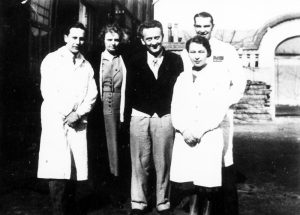
Szent-Györgyi was a tutor, helped run the university and carried out his own research at the same time. His former students recall that his lectures had a life-changing impact. He was loved, respected and looked up to by his students. He was a true role model. At the same time, he maintained a friendly, close relationship with his students, regularly inviting them to his home, to the cinema, to go for a drive with them and to play sports together.
„People think learning means stuffing the students’ heads with data from books. My view is that our heads are for thinking, and books are for refreshing our memories by reading them. Information is much easier to keep in libraries than in our heads.”
Albert Szent-Györgyi
(Moss, 2003, 86.)
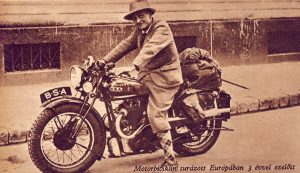
Szent-Györgyi has become one of the iconic figures of Szeged. With his motorbike, a rarity in Hungary at the time, and his Buick automobile, which was imported from America, he immediately attracted attention on the streets of the rural town. He learned to fly gliders, and in 1941 he took part in pilot training in Algyő, so that by the autumn of 1942 (he was 49 at the time!) he could fly a sport aircraft with no passengers.
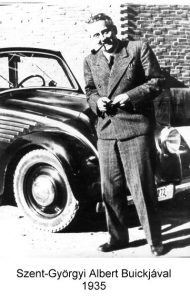
The legend of the discovery: vitamin C from the Paprika of Szeged
On the 18th of March 1932, in a lecture at a meeting of the Budapest Royal Society of Physicians, he declared that hexuronic acid and vitamin C were the same substance: „For the first time, we state publicly that hexuronic acid and vitamin C are the same.” There was ‘only’ one task left: to find a way to produce vitamin C. On March 26, 1932, the Hungarian Medical Journal also reported what was said at the lecture, namely that hexuronic acid is nothing other than vitamin C. After that, „only” one task remained: to produce vitamin C somehow.

In 1932, Albert Szent-Györgyi discovered that the paprika of Szeged was an excellent source of vitamin C. According to his own words, the story goes like this:
„One evening my wife Nelli gave me peppers for dinner. I did not feel like eating it, but I didn’t have the heart to tell her that, so I just looked at the pepper, and then I remembered that I had never examined this plant before. I told my wife that I was not going to eat it because I was going to take it to the laboratory.”
Albert Szent-Györgyi
(Moss, 2003, 108.)
About vitamin C
Another name for vitamin C is ascorbic acid. This compound is water-soluble and is a strong reducing-agent. If it is completely oxidised, it loses its vitamin potency. Formula: C6H8O6
The great vitamin C controversy
The discovery of vitamin C has not been without its share of deception and struggle. Here’s the short story of the great vitamin C controversy!
An American scientist, Charles Glen King, a young, ambitious professor at the University of Pittsburgh, has also been working on a way to isolate vitamin C. His assistant was Joseph Louis Svirbely, whose father was a Hungarian iron-worker who had emigrated to the United States. The talented boy came to Hungary to study biochemistry with the support of the International Institute of Education. As there was no biochemistry institute in Budapest at the time, the young man ended up in Szeged, in Szent-Györgyi’s laboratory. The first to compare hexuronic acid with vitamin C was Joe Svirbely, at the suggestion of Szent-Györgyi, and it turned out that the two substances are one and the same. Svirbely immediately wrote to his teacher in America, King, about this sensational discovery. A week after receiving the letter, King published his discovery in the academic journal Science that vitamin C and hexuronic acid were the same substance. Effectively, he published the scientific findings of Szent-Györgyi and Svirbely, which then appeared on the front page of the New York Times. Szent-Györgyi was sure that King had not reached the same conclusion as he had, because a few days before the announcement of the discovery, King had admitted in a letter to Svirbely that he still did not know what vitamin C was made of and what it had to do with hexuronic acid.
Since there was ample evidence that the Hungarian scientist had identified vitamin C before King’s article was published in Science, after years of fighting, Albert Szent-Györgyi’s claim was finally accepted. Nothing proves this better than the fact that he was awarded the Nobel Prize in Physiology or Medicine in 1937 for his work on vitamin C and cellular respiration.
...
Winning the Nobel Prize
28th October 1937 – telegram or phone?
"Today, the faculty of the Karolinska Institutet decided to award You this year's Nobel Prize in Physiology or Medicine for Your discoveries in connection with biological combustion processes, with special reference to Vitamin C and the catalysis of fumaric acid,
Gunnar Holmgren, rector of Karolinska Institutet.”
(Cited by: Rosta, 2013, 43.)
Contrary to popular belief, the Nobel Prize was not awarded for the discovery of vitamin C, but for clarifying the fundamental biochemical issues of the time.
The sensational event was covered in almost every major local and national newspaper. The daily newspaper of Szeged, Délmagyarország reported the fantastic news on its front page:
The following weeks were all about Szent-Györgyi. The University Council, the capital and county government commissioner of Szeged and the Mayor of Szeged welcomed the honoured scientist. On 1 December 1937 he was made an honorary citizen of the city of Szeged.
Did you know?
Albert Szent-Györgyi first lived in Szeged in a house at 14 Roosevelt square (then Rudolf square) between 1935 and 1940. He then used the money from the Nobel Prize to buy a villa in Újszeged, where he lived from 1940 to 1945.

The Nobel Prize was awarded in Stockholm on 10 December 1937. While Szent-Györgyi received the ornate gold medal from King Gustaf V of Sweden, the orchestra played the Rákóczi March.
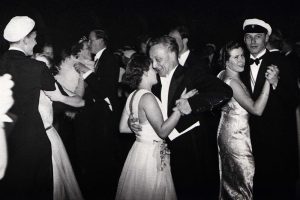

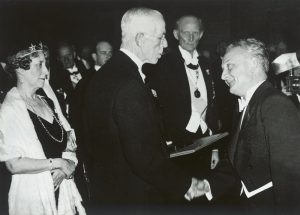
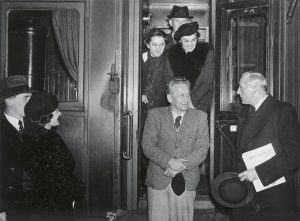



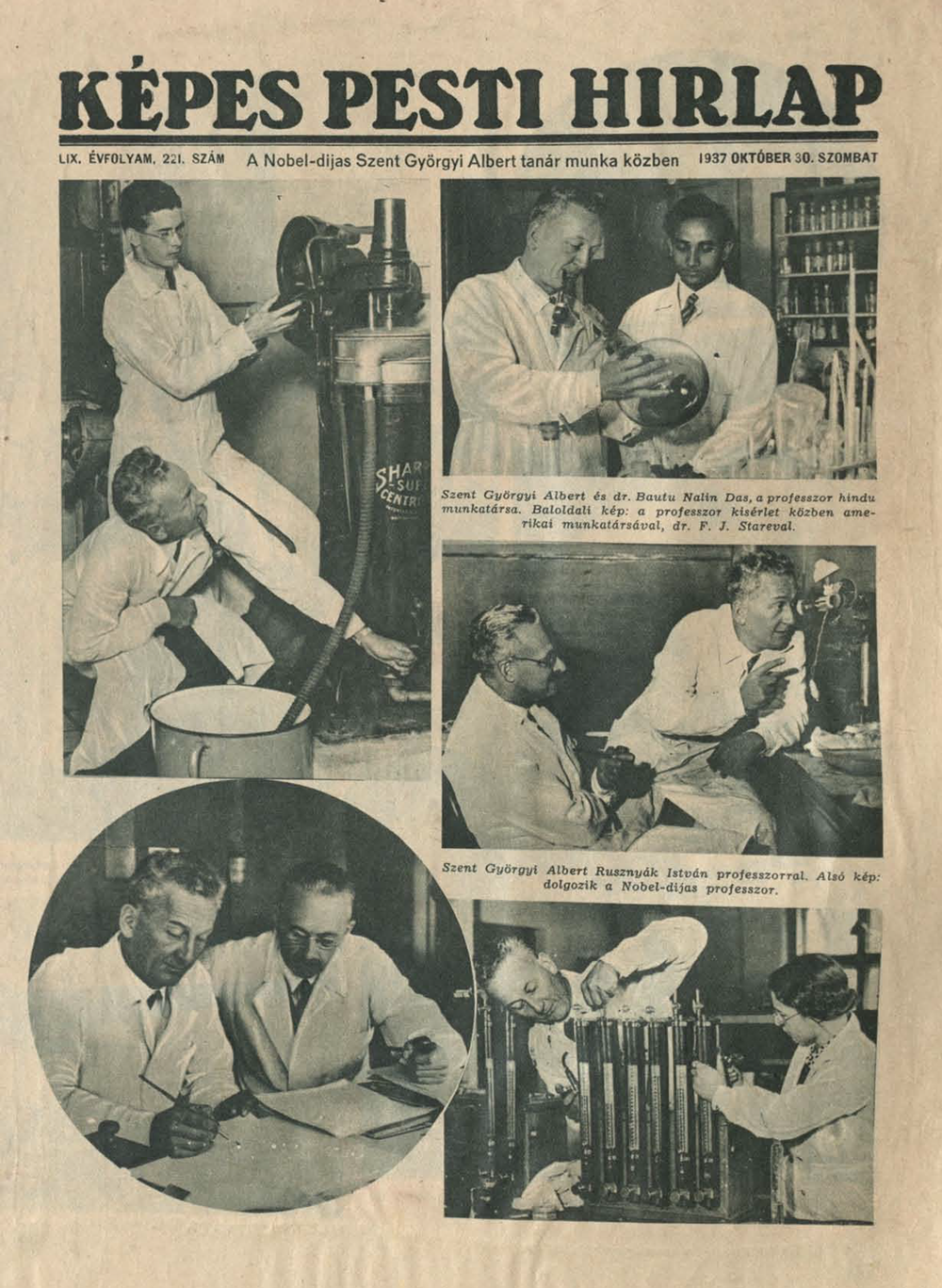
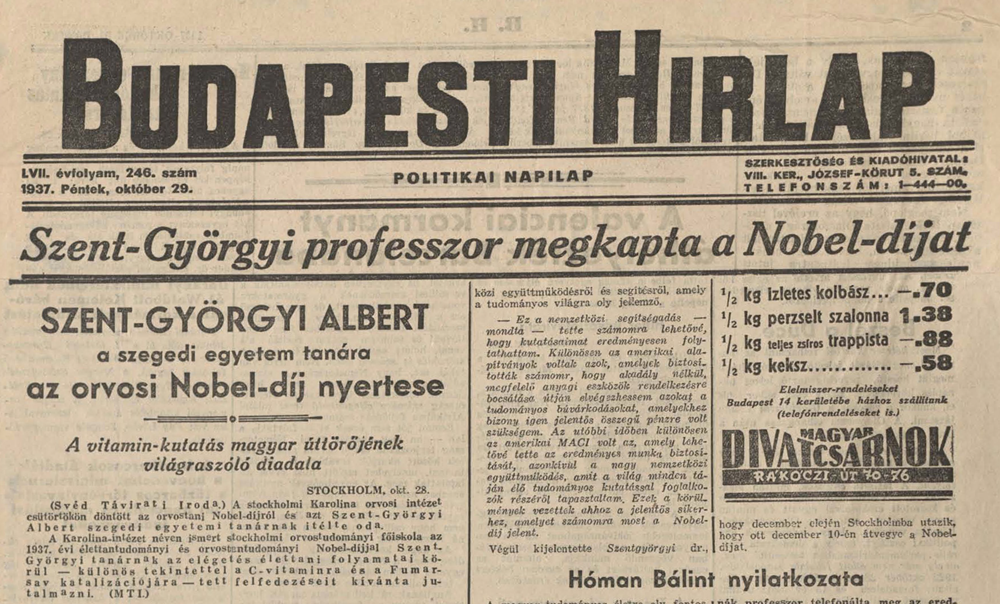
What made this Nobel Prize so special was the fact that he was the only one of the four Hungarian Nobel Laureates who was still living in his native country when he won the prize. Szent-Györgyi’s Nobel medal is still kept in Hungary, in the Hungarian National Museum.
The whole country celebrated the scientist who has become world famous. In the years after 1937, Szent-Györgyi received many honours and awards both at home and abroad, and was invited to give lectures at several European and American universities.
In 1938, Szent-Györgyi was awarded an honorary doctorate from the Faculty of Science and Mathematics at the University of Szeged.
In the academic year 1940/1941 he was elected as Rector of the University.
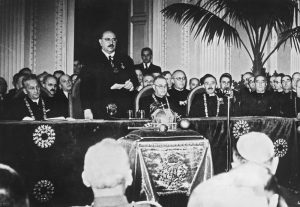
In his inspiring inaugural address, he spoke of the triple mission of universities:
The oldest vocation of the university is to collect, disseminate and enrich human knowledge. Its second vocation is to educate a small number of future scientists who will take over this vocation from us. More recent, but no less sublime, is the third vocation of the university: to train citizens for the country, armed with the weapons of the mind. I will talk about these three vocations in turn, but I would like to add that our University has a fourth special vocation: to be the centre of the Great Hungarian Plain.
Albert Szent-Györgyi
Rosta, 2013, 57.
Previous chapter
Student years and studies
Next chapter
The World War and beyond
